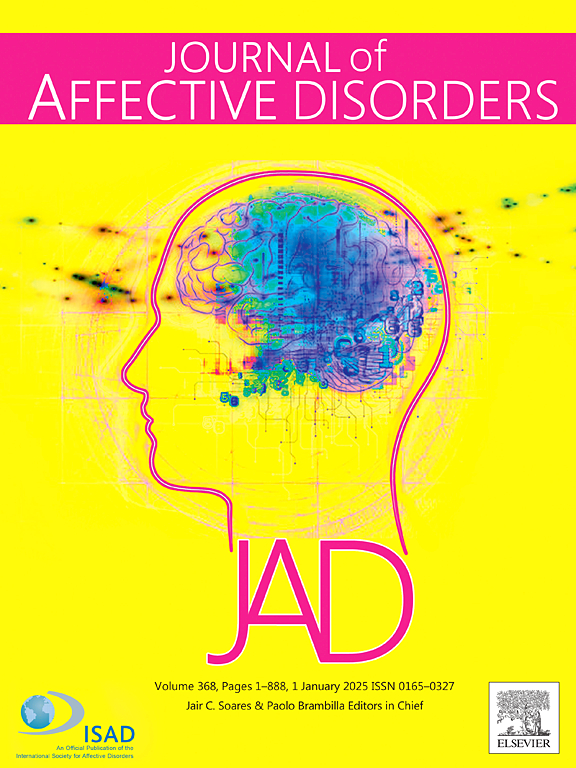A systematic review of alexithymia in young people and their parents
IF 4.9
2区 医学
Q1 CLINICAL NEUROLOGY
引用次数: 0
Abstract
Aims & hypothesis
This systematic review is the first to investigate whether there is a correlation in levels of alexithymia in young people and their parents, with the hypothesis that there is a positive correlation.
Background
Alexithymia means “no words for feelings” and encompasses three components: difficulty identifying feelings (DIF1), difficulty describing feelings (DDF2) and externally oriented thinking (EOT3). Alexithymia is common, affecting 9–17 % of men and 5–10 % of women. Alexithymic adults and children experience higher rates of mental illness. Evidence points to a multifactorial cause including neurobiological, genetic and environmental factors and experienced parenting style. Parental alexithymia has been linked with parental burnout and psychopathology in their children.
Methods
A systematic search was undertaken for studies presenting data that directly compared parent-child alexithymic characteristics/measures. Quantitative data were extracted, and a meta-analysis carried out to estimate the overall effect size of this correlation.
Results
Ten studies were included in the review, including seven in meta-analysis. There was a statistically significant weak mother-child correlation in the level of alexithymia for total scores (r = 0.24, p = 0.01) and subscale scores (DIF r = 0.18, p = 0.02; DDF r = 0.15, p = 0.04; EOT r = 0.12, p = 0.006). In relation to fathers, there was a statistically significant weak correlation with total score (r = 0.16, p = 0.01) but not subscale scores. Rates of alexithymia were much higher in young people with mental and physical health diagnoses (12–46 %), compared with non-clinical populations (9 %), in keeping with previous research.
Conclusion
Alexithymia is common in adolescents with mental and physical health diagnosis, and there is a small but consistent correlation in child-parent alexithymia, in keeping with the understanding of a multifactorial cause for alexithymia. Future research should consider family-based interventions for alexithymia.
年轻人及其父母述情障碍的系统回顾。
目的与假设:本系统综述首次探讨了年轻人述情障碍水平与其父母是否存在相关性,并假设存在正相关。背景:述情障碍的意思是“没有语言表达感觉”,包括三个组成部分:识别感觉困难(DIF1),描述感觉困难(DDF2)和外部导向思维(EOT3)。述情障碍很常见,影响9- 17% %的男性和5- 10% %的女性。有述情能力的成人和儿童患精神疾病的几率更高。有证据表明,这是多因素导致的,包括神经生物学、遗传和环境因素,以及有经验的养育方式。父母述情障碍与父母的职业倦怠和孩子的精神病理有关。方法:对直接比较亲子述情特征/测量的研究进行系统检索。提取定量数据,并进行荟萃分析以估计这种相关性的总体效应大小。结果:本综述纳入10项研究,其中meta分析纳入7项。述情障碍总分(r = 0.24,p = 0.01)与子量表得分(r = 0.18,p = 0.02;DDF r = 0.15,p = 0.04;EOT r = 0.12,p = 0.006)。对于父亲,与总分有统计学显著的弱相关(r = 0.16,p = 0.01),但与子量表得分无统计学显著的弱相关。与之前的研究一致,患有精神和身体健康诊断的年轻人述情障碍的发生率(12-46 %)比非临床人群(9 %)高得多。结论:述情障碍在精神和身体健康诊断的青少年中很常见,亲子述情障碍之间存在较小但一致的相关性,符合对述情障碍多因素病因的理解。未来的研究应考虑以家庭为基础的述情障碍干预。
本文章由计算机程序翻译,如有差异,请以英文原文为准。
求助全文
约1分钟内获得全文
求助全文
来源期刊

Journal of affective disorders
医学-精神病学
CiteScore
10.90
自引率
6.10%
发文量
1319
审稿时长
9.3 weeks
期刊介绍:
The Journal of Affective Disorders publishes papers concerned with affective disorders in the widest sense: depression, mania, mood spectrum, emotions and personality, anxiety and stress. It is interdisciplinary and aims to bring together different approaches for a diverse readership. Top quality papers will be accepted dealing with any aspect of affective disorders, including neuroimaging, cognitive neurosciences, genetics, molecular biology, experimental and clinical neurosciences, pharmacology, neuroimmunoendocrinology, intervention and treatment trials.
 求助内容:
求助内容: 应助结果提醒方式:
应助结果提醒方式:


